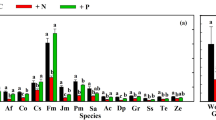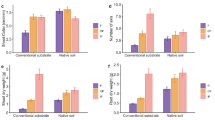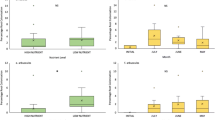Summary
Three oldfield annual species (Abutilon theophrasti Medic., Ambrosia artemisiifolia L. and Setaria lutescens (Weigel) Hubb.) were investigated. All three developed substantial mycorrhizal infections when inoculated with Glomus etunicatum Becker & Gerd. Mycorrhizal infection dramatically increased phosphorus content and dry weight of both Abutilon and Ambrosia, but did not significantly affect dry weight and only modestly increased phosphorus content of Setaria. These results were consistent with a lower level of infection and much greater root density in Setaria than in the other species. When Abutilon was grown in the presence of Setaria, mycorrhizal infection had no effect on Abutilon phosphorus content or dry weight. The depressive effect of Setaria on the response to inoculation in Abutilon was probably not caused by water soluble allelopathic chemicals from Setaria roots, but soil leachate from Abutilon plants did inhibit infection in other Abutilon plants. The data were consistent with the hypothesis that the very high root density and effective soil exploitation of Setaria reduced the benefit from mycorrhizal infection in Abutilon via phosphorus depletion in a large proportion of the available soil volume. Furthermore, even if mycorrhizal infection were capable of increasing phosphorus content of Abutilon in the presence of Setaria, the very high competitive ability of Setaria for nitrogen in the soil could have reduced the benefit of an enhanced phosphorus content. Carbon isotope ratios were reduced in Abutilon by mycorrhizal infection, indicating a possible reduction in water use efficiency.
Similar content being viewed by others
References
Allen EB, Allen MF (1984) Competition between plants of different successional stages: mycorrhizae as regulators. Can J Bot 62:2625–2629
Allen EB, Allen MF (1986) Water relations of xeric grasses in the field: interactions of mycorrhizas and competition. New Phytol 104:559–571
Anderson RC, Liberta AE (1987) Variation in vesicular-arbuscular mycorrhizal relationships of two sand prairie species. Am Midl Nat 118:56–63
Andrews RE, Newman EI (1970) Root density and competition for nutrients. Oecol Plant 5:319–334
Baath E, Hayman DS (1984) Effect of soil volume and plant density on mycorrhizal infection and growth response. Plant Soil 77:373
Baldwin JP (1975) A quantitative analysis of the factors affecting plant nutrient uptake from some soils. J Soil Sci 26:195–206
Bazzaz FA (1984) Demographic consequences of plant physiological traits: some case studies. In: Dirzo R, Sarukhan J (eds) Perspectives in Plant Population Ecology, SinauerAssociates, Sunderland, Mass, pp 324–346
Benner BL, Bazzaz FA (1987) Effects of timing of nutrient addition on competition within and between two annual plant species. J Ecol 75:229–245
Bethlenfalvay GJ, Pacovsky RS (1983) Light effects in mycorrhizal soybeans. Plant Physiol 73:969–972
Bethlenfalvay GJ, Dakessian S, pacovsky RS (1984) Mycorrhizae in a southern California desert: ecological implications. Can J Bot 62:519–524
Biondini ME, Bonham D, Redente EF (1985) Secondary successional patterns in a sagebrush (Artemisia tridentata) community as they relate to soil disturbance and soil biological activity. Vegetatio 60:25–36
Cook BD, Jastrow JD, Miller RM (1988) Root and mycorrhizal endophyte development in a chronosequence of restored tall-grass prairie. New Phytol 110:355–362
Crowell HF, Boerner REJ (1988) Influences of mycorrhizae and phosphorus on belowground competition between two old-field annuals. Env Exp Bot 28:381–392
Dhillion SS, Anderson RC, Liberta AE (1988) Effect of fire on the mycorrhizal ecology of little bluestem (Schizachyrium scoparium). Can J Bot 66:706–713
Ehleringer JR, Osmond CB (1989) Stable isotopes. In: Pearcy RW, Ehleringer JR, Mooney HA, Rundel PW (eds) Plant Physiological Ecology, Field Methods and Instrumentation. Chapman and Hall, London, pp 281–300
Fitter AH (1977) Influence of mycorrhizal infection on competition for phosphorus and potassium by two grasses. New Phytol 79:119–125
Fitter AH (1986) Effect of benomyl on leaf phosphorus concentration in alpine grasslands: a test of mycorrhizal benefit. New Phytol 103:767–776
Fitter AH, Hay RKM (1987) Environmental Physiology of Plants, 2nd ed. Academic Press, London, p 423
Garbutt K, Bazzaz FA (1987) Population niche structure. Differential response of Abutilon theophrasti progeny to resource gradients. Oecologia 72:291–296
Gemma JN, Koske RE (1988) Pre-infection interactions between roots and the mycorrhizal fungus Gigaspora gigantea: chemotropism of germ-tubes and root growth response. Trans Br Mycol Soc 91:123–132
Grime Jp, Mackey JML, Hillier SH, Read DJ (1987) Floristic diversity in a model system using experimental microcosms. Nature 328:420–422
Haselwandter K(1987)Mycorrhizal infection and its possible ecological significance in climatically and nutritionally stressed alpine plant communities. Angew Botanik 61:107–114
Hayman DS (1983) The physiology of vesicular-arbuscular endomycorrhizal symbiosis. Can J Bot 61:944–963
Heap AJ, Newman EI (1980) The influence of vesicular-arbuscular mycorrhizas on phosphorus transfer between plants. New Phytol 85:173–179
Hetrick BAD, Bloom J (1983) Vesicular-arbuscular mycorrhizal fungi associated with native tall grass prairie and cultivated winter wheat. Can J Bot 61:2140–2146
Hetrick BAD, Wilson GWT, Hartnett DC (1989) Relationship between mycorrhizal dependence and competitive ability of two tallgrass prairie grasses. Can J Bot 67:2608–2615
Janos DP (1975) Vesicular-arbuscular mycorrhizal fungi and plant growth in a Costa Rican lowland rainforest. PhD Diss, univ Michigan, Ann Arbor, p 172
Janos DP (1980) Mycorrhizae influence tropical succession. Biotropica 12 [S]:56–64
Janos DP (1985) Mycorrhizal fungi: agents of symptoms of tropical community composition?In: Molina R (ed) Proceedings 6th North American Conference on Mycorrhizae. Forest Research Laboratory, Corvallis, pp 98–103
Janos DP (1987) VA mycorrhizas in humid tropical ecosystems. In: Safir ER (ed) Ecophysiology of VA Mycorrhizal Plants, CRC Press, Boca Raton, p 232
Jensen WA (1962) Botanical Histochemistry. Freeman, San Francisco, p 408
Jocic B, Saric MR (1983) Efficiency of nitrogen, phosphorus and potassium use by corn, sunflower and sugarbeet for the synthesis of organic matter. Plant soil 72:219–223
Koide R (1985) The effect of VA mycorrhizal infection and phosphorus status on sunflower hydraulic and stomatal properties. J Exp Bot 36:1087–1098
Koide R (1990) Physiology of the mycorrhizal plant. In: Tommerup IC (ed) Mycorrhiza: A Synthesis, Vol. 8 of Advances in Plant Pathology, Academic Press
Koide R, Elliott G (1989) Cost, benefit and efficiency of the vesiculararbuscular mycorrhizal symbiosis. Funct Ecol 3:252–255
Koide R, Li M (1989) Appropriate controls for vesicular-arbuscular mycorrhiza research. New Phytol 111:35–44
Koide R, Li M (1990) On host regulation of the vesiculararbuscular mycorrhizal symbiosis. New Phytol 114:59–74
Koide R, Mooney HA (1987) Spatial variation in inoculum potential of vesicular-arbuscular mycorrhizal fungi caused by formation of gopher mounds. New Phytol 107:173–182
Koide R, Huenneke LF, Hamburg S, Mooney HA (1988) Effects of applications of fungicide, phosphorus and nitrogen on the structure and productivity of an annual serpentine plant community. Funct Ecol 2:335–344
Lee H, Zangerl AR, Garbutt K, Bazzaz FA (1986) Within and between species variation in response to environmental gradients in Polygonum pensylvanicum and Polygonum virginianum. Oecologia 68:606–610
Logan VS, Clarke PJ, Allaway WG (1989) Mycorrhizas and root attributes of plants of coastal sand-dunes of New South Wales. Aust J Plant Phys 16:141–146
Machlis L, Torrey JG (1956) Plants in Action. Freeman, San Francisco
McConnaughay KDM, Bazzaz FA (1987) The relationship between gap size and performance of several colonizing annuals. Ecology 68:411–416
Miller RM (1979) Some occurrences of vesicular-arbuscular mycorrhiza in natural and disturbed ecosystems of the Red Desert. Can J Bot 57:619–623
Newman EI, Ritz K (1986) Evidence on the pathways of phosphorus transfer between vesicular-arbuscular mycorrhizal plants. New Phytol 104:77–87
Nye PH, Tinker PB (1977) Solut movement in the soil-root systems. University of California Press, Berkeley, p 342
Parrish JAD, Bazzaz FA (1976) Underground niche separation in successional plants. Ecology 57:1281–1288
Puppi G, Riess S (1987) Role and ecology of VA mycorrhizae in sand dunes. Angew Botanik 61:115–126
Read DJ, Francis R, Finlay RD (1985) Mycorrhizal mycelia and nutrient cycling in plant communities. In: Fitter AH (ed),Ecological Interactions in Soil. Blackwell Scientific Publications, Oxford, pp 193–217
Salisbury FB, Ross CL (1978) Plant Physiology, second ed, Wadsworth Publishing Company, Belmont, p 422
STSC (1987) Statgraphics statistical graphics system, version 2.6. STSC, Inc, Rockville, MD, USA
Watanabe FS, Olsen SR (1965) Test of an ascorbic acid method for determining phosphorus in water and NaHCO3 extracts from soil. Soil Sci Soc Proc 29:677–678
Whittingham J, Read DJ (1982) Vesicular arbuscular mycorrhiza in natural vegetation systems. III. Nutrient transfer between plants with mycorrhizal interconcentions. New Phytol 90:277–284
Wieland NK, Bazzaz FA (1975) Physiologicalecology of three codominant successional annuals. Ecology 56:681–688
Author information
Authors and Affiliations
Rights and permissions
About this article
Cite this article
Koide, R.T., Li, M. Mycorrhizal fungi and the nutrient ecology of three oldfield annual plant species. Oecologia 85, 403–412 (1991). https://doi.org/10.1007/BF00320617
Received:
Accepted:
Issue Date:
DOI: https://doi.org/10.1007/BF00320617




